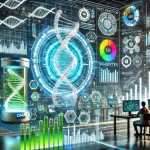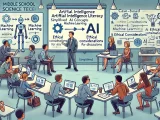
The Digital Biologist: Navigating Genomics, Proteomics & AI in Modern Research
July 30, 2025The landscape of biological research has undergone a profound transformation. What was once primarily a wet-lab endeavor now increasingly begins at the computer screen, driven by an unprecedented deluge of data from genomics, proteomics, and beyond. This isn’t just a minor adjustment; it’s a fundamental reorientation of how we understand life itself. If you’re a life scientist, student, or simply curious about how technology is revolutionizing biology, mastering bioinformatics is no longer optional—it’s essential.
This guide distills the core wisdom from foundational bioinformatics texts, updated with the cutting-edge advancements shaping the field in 2025. Get ready to unlock the secrets of life, one algorithm at a time.
The Core Principles: Life’s Digital Blueprint
At its heart, bioinformatics is the art and science of applying information technology to biological data, fundamentally “the science of using information to understand biology”. It’s about taking the complex, messy reality of living systems and translating it into a language computers can understand, analyze, and help us interpret. Our journey begins with the Central Dogma of Molecular Biology: the fundamental flow of genetic information from DNA to RNA to protein. This elegant principle underpins all life, explaining how DNA replicates itself, is transcribed into RNA, and then RNA is translated into the proteins that carry out life’s functions. Errors in this process, known as mutations, drive evolution, and by analyzing these changes computationally, we can trace the history of life and predict future biological behaviors.
But how do we analyze something as intricate as a protein’s 3D structure or an entire metabolic pathway? The answer lies in modeling. Bioinformatics excels at abstracting complex biological systems into simplified, quantifiable representations. Imagine representing a vast 3D protein as a 1D string of amino acid letters, or a cell’s intricate biochemical network as a series of mathematical equations. These models allow us to analyze, predict, and generate testable hypotheses, guiding experimental design with unprecedented precision. The primary purpose of theoretical modeling is to generate testable hypotheses, not definitive answers.
Your Command Center: The Digital Workbench
Before diving into complex analyses, every aspiring bioinformatician needs a robust digital environment. Unix/Linux remains the gold standard operating system for scientific computing. Its command-line interface, while initially intimidating, offers unparalleled efficiency and control for managing massive datasets and automating complex workflows—tasks that are simply impractical with graphical interfaces. You’ll learn to navigate its file system, organize your research data systematically, and master essential commands like ls (list files), cd (change directory), cp (copy), mv (move), and rm (remove).
Beyond your local machine, the World Wide Web is your global library and data repository. You’ll learn to effectively use search engines (understanding boolean logic and search engine algorithms), navigate scientific literature databases like PubMed, and access critical public biological databases such as the Protein Data Bank (PDB) for 3D molecular structures and GenBank for DNA and RNA sequences.
Modern Advance: Cloud Computing
The concept of the “digital workbench” has evolved dramatically with cloud computing. Researchers now leverage scalable, on-demand cloud resources (like Amazon S3, Google Cloud Storage, Google Genomics, Amazon Omics) for massive data storage, processing power, and applications. This eliminates the need for expensive local hardware and fosters global collaboration, allowing for centralized data management and automated workflows, making large-scale bioinformatics more accessible than ever.
Decoding Life’s Data: Sequence & Structure Insights
With your digital workbench set up, you’re ready to wield the specialized tools that drive biological discovery:
Sequence Analysis Fundamentals
This is the bedrock. You’ll master pairwise sequence comparison using tools like BLAST and FASTA to find similarities andInfer function or evolutionary relationships between unknown and known sequences. Beyond pairs, multiple sequence alignment tools like ClustalW reveal deeper evolutionary connections and conserved functional patterns across gene families. This also underpins phylogenetic analysis (building evolutionary trees) and motif discovery, identifying short, conserved patterns predictive of molecular function.
Protein Structure Visualization & Properties
Understanding a protein’s 3D shape is key to its function. You’ll learn to visualize these complex structures using software like RasMol and Cn3D, and understand the underlying protein chemistry and interatomic forces that govern their folding. The ultimate challenge remains predicting protein structure from sequence alone. While ab-initio prediction was once a distant dream, homology modeling (using known structures as templates) has been a practical success.
Modern Advance: AlphaFold & AI in Protein Structure
The landscape of protein structure prediction has been revolutionized by AlphaFold. Developed by Google DeepMind, this AI program uses deep learning to predict protein 3D structures with accuracy competitive with experimental methods, even for targets without existing templates. AlphaFold 3, announced in May 2024, further extends this capability to predict the structures of complexes involving proteins, DNA, RNA, and various ligands, marking a significant leap in understanding molecular interactions. The AlphaFold Protein Structure Database now provides open access to over 200 million predicted structures, accelerating research worldwide.
The Omics Revolution & Systems Thinking
The “omics” era brings immense data volumes and new analytical challenges:
Genomics: Sequencing & Annotation
You’ll explore tools for genome sequencing and assembly (like Phred and Phrap), genome annotation (MAGPIE, COG) to label functional regions, and comparative genomics (PipMaker, MUMmer) to identify similarities and differences across entire genomes.
Modern Advance: Next-Generation Sequencing (NGS)
Next-Generation Sequencing (NGS) platforms (Illumina, Pacific Biosciences, Oxford Nanopore) have transformed genomics, enabling rapid, cost-effective sequencing of millions of DNA fragments simultaneously. This has fueled whole-genome sequencing, whole-exome sequencing, and single-molecule sequencing, providing unprecedented detail into genetic variations and disease mechanisms. Combining short and long-read sequencing approaches has also been successfully applied for accurate genome assembly without a reference sequence.
Functional Genomics & Microarrays
These technologies enable thousands of gene expression experiments simultaneously, posing bioinformatics challenges in chip design, image analysis, and clustering expression profiles.
Proteomics
Techniques that simultaneously study the entire protein complement of a cell, typically combining 2D gel electrophoresis with mass spectrometry for protein identification and quantification.
Modern Advance: Advanced Mass Spectrometry
Recent advancements in mass spectrometry (MS) technology, including high-resolution mass analyzers like Orbitrap and quadrupole-time-of-flight (Q-TOF), have dramatically improved the sensitivity, resolution, and speed of protein analysis, enabling comprehensive studies of complex biological systems.
Systems Biology & Multi-omics
This field integrates data from various high-throughput technologies (genomics, transcriptomics, proteomics, metabolomics, phenomics) to understand biological organisms as a whole, often involving computational modeling.
Modern Advance: AI/ML in Drug Discovery
AI and Machine Learning (ML) are rapidly transforming computational drug discovery. Virtual screening (VS), a computational technique to analyze large chemical libraries for promising drug candidates, is now heavily augmented by AI/ML. Deep learning models such as Convolutional Neural Networks (CNNs) and Graph Neural Networks (GNNs) enhance docking accuracy and extract hidden patterns from complex datasets. AI-driven algorithms like KarmaDock and DeepDock are improving protein-ligand docking accuracy, accelerating the identification of potential therapeutic agents, including novel approaches like PROTACs (proteolysis-targeting chimeras).
Empowering Your Research: Programming & Data Intelligence
To truly scale your research, extract deeper insights, and build custom solutions, proficiency in programming and robust data management are critical:
Automating with Perl
Perl remains an ideal scripting language for bioinformatics, excelling at handling large text files and detecting patterns. You’ll learn basic concepts, powerful regular expressions, and how to write scripts to parse complex outputs (like BLAST results) and automate tedious tasks.
Building Biological Databases
Understanding database concepts is essential for managing the ever-growing repositories of biological information. You’ll differentiate between flat file and relational databases (RDBMS) and learn SQL (Structured Query Language) to query and manipulate data efficiently.
Visualization & Data Mining
Raw data is meaningless without interpretation. You’ll explore tools for visualizing your results, from simple 2D plots to complex 3D representations of sequences, networks, and pathways. Furthermore, data mining and machine learning techniques (like decision trees, neural networks, and Support Vector Machines) help you find, interpret, and evaluate hidden patterns within vast biological datasets, leading to new hypotheses.
Your Journey into the Digital Lab Awaits
Bioinformatics is a dynamic, interdisciplinary field that provides the computational engine for accelerating biological discovery. It demands a blend of deep biological understanding and robust computational skills. While tools and technologies will continue to evolve at a breathtaking pace, the core principles of critical thinking, problem decomposition, and rigorous data analysis remain timeless.
By embracing these skills and staying abreast of the latest AI and technological breakthroughs, you’ll be equipped to tackle the most pressing questions in modern biology, transforming raw data into profound insights and contributing to the next generation of scientific innovation. The future of biological research is computational, and your expertise is its driving force.


















